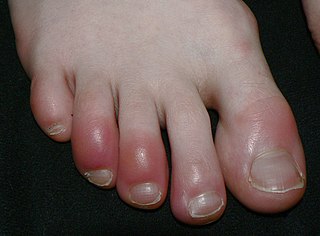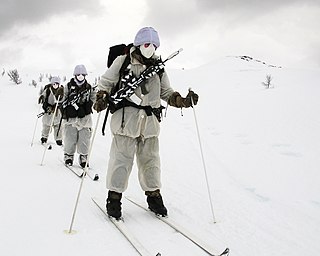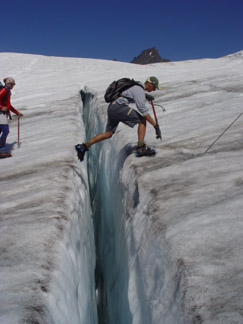
A blister is a small pocket of body fluid within the upper layers of the skin, usually caused by forceful rubbing (friction), burning, freezing, chemical exposure or infection. Most blisters are filled with a clear fluid, either serum or plasma. However, blisters can be filled with blood or with pus.

An ulcer is a sore on the skin or a mucous membrane, accompanied by the disintegration of tissue. Ulcers can result in complete loss of the epidermis and often portions of the dermis and even subcutaneous fat. Ulcers are most common on the skin of the lower extremities and in the gastrointestinal tract. An ulcer that appears on the skin is often visible as an inflamed tissue with an area of reddened skin. A skin ulcer is often visible in the event of exposure to heat or cold, irritation, or a problem with blood circulation.

A callus is an area of thickened and sometimes hardened skin that forms as a response to repeated friction, pressure, or other irritation. Since repeated contact is required, calluses are most often found on the feet and hands, but they may occur anywhere on the skin. Some degree of callus, such as on the bottom of the foot, is normal.

Frostbite is a skin injury that occurs when exposed to extreme low temperatures, causing the freezing of the skin or other tissues, commonly affecting the fingers, toes, nose, ears, cheeks and chin areas. Most often, frostbite occurs in the hands and feet. The initial symptoms are typically a feeling of cold and tingling or numbing. This may be followed by clumsiness with a white or bluish color to the skin. Swelling or blistering may occur following treatment. Complications may include hypothermia or compartment syndrome.

Chilblains, also known as pernio, is a medical condition in which damage occurs to capillary beds in the skin, most often in the hands or feet, when blood perfuses into the nearby tissue, resulting in redness, itching, inflammation, and possibly blisters.

Athlete's foot, known medically as tinea pedis, is a common skin infection of the feet caused by a fungus. Signs and symptoms often include itching, scaling, cracking and redness. In rare cases the skin may blister. Athlete's foot fungus may infect any part of the foot, but most often grows between the toes. The next most common area is the bottom of the foot. The same fungus may also affect the nails or the hands. It is a member of the group of diseases known as tinea.

Diseases of the foot generally are not limited, that is they are related to or manifest elsewhere in the body. However, the foot is often the first place some of these diseases or a sign or symptom of others appear. This is because of the foot's distance from the central circulation, the heart and its constant exposure to pressures from the ground and the weight of the body.

Cold-weather warfare, also known as arctic warfare or winter warfare, encompasses military operations affected by snow, ice, thawing conditions, or cold, both on land and at sea, as well as the strategies and tactics used by military forces in these situations and environments.

Onychomycosis, also known as tinea unguium, is a fungal infection of the nail. Symptoms may include white or yellow nail discoloration, thickening of the nail, and separation of the nail from the nail bed. Toenails or fingernails may be affected, but it is more common for toenails. Complications may include cellulitis of the lower leg. A number of different types of fungus can cause onychomycosis, including dermatophytes and Fusarium. Risk factors include athlete's foot, other nail diseases, exposure to someone with the condition, peripheral vascular disease, and poor immune function. The diagnosis is generally suspected based on the appearance and confirmed by laboratory testing.

Outdoor recreation, such as hiking, camping, canoeing, cycling, or skiing, entails risks, even if participants do not recklessly place themselves in harm's way. In some circumstances, such as being in remote locations or in extreme weather conditions, even a minor accident may create a dangerous situation that requires survival skills. However, with correct precautions, even fairly adventurous outdoor recreation can be enjoyable and safe.

Trench foot, also known by other names, is a type of foot damage due to moisture. Initial symptoms often include tingling or itching which can progress to numbness. The feet may become red or bluish in color. As the condition worsens the feet can start to swell and smell of decay. Complications may include skin breakdown or infection.

Pitted keratolysis is a bacterial skin infection of the foot. The infection is characterized by craterlike pits on the sole of the feet and toes, particularly weight bearing areas.

Tropical ulcer, more commonly known as jungle rot, is a chronic ulcerative skin lesion thought to be caused by polymicrobial infection with a variety of microorganisms, including mycobacteria. It is common in tropical climates.
Sucking blisters are a cutaneous condition on newborns that is present on their extremities at birth. This is not to be confused with sucking pads, which are similar in appearance. Sucking blisters are due to natural neonatal sucking reflexes on the affected areas in utero. These sucking blisters become present at birth when the sucking movements are very aggressive while in the uterus. These blisters are commonly found on the newborn's arms, fingers, or any body part they are able to suck on. It is a very rare condition, seen in less than 1% of newborns. It is difficult to diagnose because its appearance can be mistaken as other skin conditions. Diagnosis is usually done by eliminating other possible cutaneous conditions. This process of elimination includes examining blood culture, lesions, and inflammatory markers. This skin condition is usually self-inflicted, benign and can heal on its own. Sucking blisters do typically not require medical treatment and disappear within a week.

Cold injury is damage to the body from cold exposure, including hypothermia and several skin injuries. Cold-related skin injuries are categorized into freezing and nonfreezing cold injuries. Freezing cold injuries involve tissue damage when exposed to temperatures below freezing. Nonfreezing cold injuries involve tissue damage when exposed to temperatures often between 0-15 degrees Celsius for extended periods of time. While these injuries have disproportionally affected military members, recreational winter activities have also increased the risk and incidence within civilian populations. Additional risk factors include homelessness, inadequate or wet clothing, alcohol abuse or tobacco abuse, and pre-existing medical conditions that impair blood flow.

Maceration is defined as the softening and breaking down of skin resulting from prolonged exposure to moisture. It was first described by Jean-Martin Charcot in 1877. Maceration is caused by excessive amounts of fluid remaining in contact with the skin or the surface of a wound for extended periods.
Non-freezing cold injuries (NFCI) is a class of tissue damage caused by sustained exposure to low temperature without actual freezing. There are several forms of NFCI, and the common names may refer to the circumstances in which they commonly occur or were first described, such as trench foot, which was named after its association with trench warfare. NFCI is caused by microvascular endothelial damage, stasis and vascular occlusion and is characterised by peripheral neuropathy. NFCI generally affects the hands or feet during exposure to temperatures just above freezing, often wet, and is typically found in soldiers.
Two feet-one hand syndrome(TFOHS), is a long-term fungal condition where athlete's foot or fungal toe nail infections in both feet is associated with tinea manuum in one hand. Often the feet are affected for several years before symptoms of a diffuse scaling rash on the palm of one hand appear, which is when most affected people then seek medical help.















